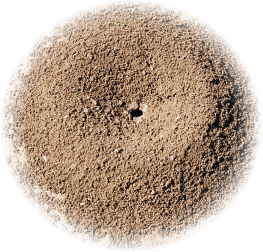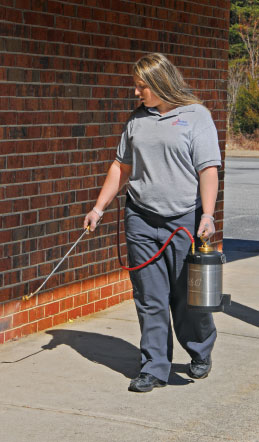They march on … 
in impossible numbers, invading any place where they can find shelter, food and water. Board up the doors and windows, and they’ll still find a way in. You might take down a few with select weapons from your arsenal, but they return in armies, leaving frustration in their wake. They are motivated by an undying desire to survive and thrive:
Must. Find. Shelter. Food. Water.
You think you’ve won and eradicated a customer’s problem — but then, unbelievably, they return.
A phone rings. The dreaded callback from a victim who demands you face the enemy once again, because you are the last defense between helpless property owners and the armies that march on … and on … and on.
Like zombies, they return — again and again. They’re ants. Despite their different sizes, shapes, colors, preferences and behavior, they share a key characteristic: They seem unstoppable.
The ant/zombie comparison isn’t lost on Patrick Walsh — co-owner, vice president and director of operations for VanWal Pest Elimination in Kernersville N.C. — and his wife, co-owner Michelle Walsh. In fact, the visual analogy appears on some of the vehicles in VanWal’s fleet — truck wraps featuring lumbering zombies that look like they’re about to stumble right off the side of the vehicles and into the real world.
Every zombie fan knows that to take one down, you have to shoot it in the head. Are ants more difficult to stop than zombies? In some cases, yes. Pest management professionals’ (PMPs’) countless ant job callbacks and return trips indicate ants might in fact be super zombies.
Night of the Living Ants
While VanWal has yet to deal with its first zombie call, Walsh and company are prepared for a zombie war because they’ve been fighting ants for years.
VanWal has battled ants so successfully for so long that, the company’s callback rate is nearly nil.
“Our service team’s callback rate averages less than a 0.25 percent,” Patrick Walsh says. “Ant job callbacks are almost non-existent in our company because we start by setting our goal at total elimination, and we use every weapon needed to win each battle.
“From day one, our techs are taught to treat every job like it’s for their mom,” Walsh adds. “And no one likes to think of dear Mom fending off zombie pests.”
But not everyone battles zombie pests with the same success as VanWal. [See Pest Management Professional’s (PMP’s) 2014 Ant Management Survey analysis on AM12.] Only 5 percent of survey respondents reported no ant job callbacks in 2013, but 39 percent reported a 5-percent or higher callback rate. Twenty-two percent reported a 10-percent or higher ant job callback rate, and 10 percent reported a callback rate of more than 20 percent.
Walsh admits there are situations that smack him upside the head with the hard truth about the determination and dedication some pest management battles require.
“And it’s always ants that do that.”
Who they gonna call … again?
There are several scenarios that make callbacks more likely. Chris Cavanagh, associate certified entomologist and vice president of Petri Positive Pest Solutions in Pompano
Beach, Fla., pinpoints a few common callback causes: A technician might have located and eliminated one or more ant nests, but other nests might remain. Incorrect selection of control products and strategies, or not telling customers how long they might need to wait before seeing results following an ant treatment, also can trigger callbacks.
David Moore, manager of technical services for Dodson Pest Control in Lynchburg, Va., concurs.
“A big reason customers call back and complain is because PMPs have not managed clients’ treatment expectations,” Moore says. “Other times, an ant colony from a surrounding area takes the place of the previous colony, which prompts a client to call back.”
Using the wrong control technologies and techniques also can thwart a treatment’s effectiveness.
“We have to remember these infestations are impacting our customers’ quality of life,” Moore adds. “It’s important we be as understanding as possible when they keep coming to us for help.”
Adding insult to injury, sometimes clients spray over-the-counter repellents that counteract professionals’ ant management programs, says Jason Strickland, manager of Gulf Coast Pest Control in Panama City, Fla. “Customers get frustrated when they don’t see immediate results, so it’s important to educate them upfront about what they should and should not do, and the typical time and steps successful ant management usually requires.”
Rusty Markland, corporate director at PestNow/Superior Pest Management in Sterling, Va., adds that saying something as seemingly benign as “no problem” to a client
sometimes instigates these problems.
“Unless they’re told otherwise, most customers don’t expect to see any ants after an initial treatment,” Markland says. “That often-unrealistic expectation can trigger callbacks.”
Cavanagh agrees: “Providing realistic expectations for clients means informing them that ant control requires follow up and can be an ongoing battle.”
“It also doesn’t help when an initial treatment uses baits and non-repellents on the interior of a structure and repellents on the exterior,” Markland adds. “This can stir up ants from everywhere and repel them inside.”
Crushing the Callback
Battling ants is a team effort.
“We’ve found the best way to resolve an ant callback is to let the tech who performed the original treatment try a re-treat to solve the issue,” Walsh says. “If a second callback occurs, we send a service supervisor or a different tech because sometimes a new set of eyes is all that’s needed. Sometimes the solution is simple and obvious — to another tech.”
Ant control often requires a lot of inspecting and detective work.
A lack of time can hinder control, Cavanagh warns.
Sometimes, single technicians don’t have the time necessary to identify and eliminate all ant problems.
“In those cases, it helps to have a trouble-shooter or supervisor available who can spend extra time assisting the tech with difficult callbacks,” Cavanagh adds.
Thorough inspection and proper ant identification are a must.
Is it a one- or two-node ant? Is it a polygyny species, which requires the elimination of multiple queens, or a monogyny species, requiring just one queen be taken out?
“Different ants have different habits and harborages, so don’t just look down for a source. Look up, down and all around,” Moore says. “And remember: As is the case with many insects, controlling a location’s moisture will directly impact the suitability of the harborage.”
Moore encourages interviewing clients, directly treating nests and removing conducive conditions. Exclusion might include caulking around windows, in bathrooms and kitchens.
“Treat your callbacks as you do new jobs,” Markland advises. “If you schedule new jobs for same-day treatments, why wouldn’t you also visit existing accounts the same day they place callbacks — especially if your ant management service is warranteed?
“Putting off callback work can be a death sentence for a company,” Markland warns.
Making Money from Anthills

Ant nests aren’t always as easy to spot as this one. PMPs say they need to look up, down and all around.
Maybe your company doesn’t generate much ant business, but now you feel as though you have a better understanding of how to deal with these zombie pests efficiently. You want more ant business, but you’re not sure how to get it? No problem.
“Ants sell themselves,” Markland explains. “When a company doesn’t win an ant job, it’s often because the person charged with making your case actually unsold the job. Ant jobs often are sold when the phone rings.”
Companies should invest in ant-specific training for sales representatives and technicians, Cavanagh adds. Then firms should market themselves as ant specialists — reinforcing this in all print advertising, as well as on the Internet and social media.
“Another good strategy is to have your sales reps and technicians cloverleaf around customers who are already being served for ant infestations, as ants are often a problem for the entire neighborhood,” Cavanagh adds.
Walsh suggests companies study their top competitors, prospects and referral streams.
“Educate yourself about the competition, and then separate your company from the pack,” Walsh says. “Survey potential clients: What pest management services are they receiving? What are their top needs and wants? Last but not least, don’t underestimate the power of leveraging your current ant management accounts to create a referral program that rewards those customers and brings in business.”
Final Zombie-Pest Control Tips & Tricks
The movie “Zombieland” begins with a comprehensive list of rules for surviving a zombie takeover. (Example: The “double tap” — Never assume you’ve killed a zombie in one shot. Double check and reload if necessary.)
This is good advice for zombie management professionals (ZMPs). Unfortunately, shooting zombie pests in the head, ant-by-ant, isn’t practical (or legal).
“One of the biggest problems is when customers don’t cooperate as much as we need them to,” Cavanagh says. “This means getting them to eliminate conducive conditions, such as tree branches touching structures, and poor sanitation, such as leaving food out.”
Even if customers feign cooperation, Walsh advises against taking their word as the only indicator of their compliance.
“Do your own investigation. See if you can uncover what is fostering ant problems on the interior and exterior,” Walsh adds. “Locate and identify the type — or types — of ant(s) you are dealing with and all conducive conditions.”
When a technician discovers ants during a routine maintenance service, he might not have enough time to fully address the problem, Walsh says. VanWal solved this problem by not overloading techs with jobs. VanWal’s techs average five to seven jobs a day, which usually gives them enough time to do each ant job. If, for any reason, they can’t fully inspect and treat in one visit, they usually return to the account at the end of the day.
Another solution to problems created by lack of time is hiring a dedicated representative who’s available during the busy ant season and can help follow up and assist on tough jobs.
Walsh also suggests technicians simply take a step back and look.
“Upon arrival, do a 360-degree evaluation of the entire account and its exterior surroundings,” Walsh says. “Contributing factors can include trees, shrubs, plants, light poles, sheds, gutters and downspouts.”
Cavanagh adds that all inspections should include the identification of pheromone trails.
“Apply a few different types of bait near the pheromone trails to see which ones the ants respond best to,” Cavanagh says. “Then follow ant trails to determine possible nesting locations, such as trees, stumps, under rocks, in mulch, near voids, and in attics and crawlspaces.”
Once techs identify the nests, Cavanagh suggests treating them directly with liquid, dust or aerosol products.
Walsh emphasizes education that reaches well beyond ant identification and inspection.
“Learn about landscaping practices and products, as well as local soil conditions,” he says. “It’s also wise to learn a little about construction. Watch a home or commercial building being constructed, so you can truly understand the microenvironments ants are infesting.”
Don’t underestimate the power of cleaning known and suspected entry points with a strong detergent to remove pheromone trails and prevent further home invasions. And always seal in plastic containers food that’s attractive to ants, Strickland adds.
Other top tips offered by our experts include:
- Interview the customer to determine where the ants are.
- Identify the ant types and if they are multi-queen or super-colony ant species.
- Don’t stop at one nest or species ID. Take a second look to ensure you’re not dealing with more than one nest and/or species.
- With commercial accounts, remember staff often have a better idea of ant activity than the owners and managers.
- Don’t undersell the job. Allocate enough time and materials to do the job right the first time — and price it appropriately.
- After you’ve put together a plan for ant colony elimination, develop a program to prevent future infestations.
- Let customers know you’re aware this isn’t a new problem for them. Most people don’t call for treatment until they’ve tried several times unsuccessfully to take care
of the problem. pmp
… From Ants To Zombies

Michelle and Patrick Walsh appear unphased by the zombies coming their way. Their son, James, looks proud — probably because the zombies were his idea.
Patrick and Michelle Walsh’s son, James, was the first to say:
“Let’s put zombies on the trucks!” Patrick Walsh — co-owner, vice president and director of operations for VanWal Pest Elimination in Kernersville, N.C. — had utilized truck-wrap advertising before, but it was his son who sought to throw zombies in the mix.
“We struggled for weeks about how to tie in zombies with bugs,” Patrick Walsh says. “My wife and I are huge fans of “The Walking Dead” [AMC’s popular zombie drama], and then it hit me when I read about “zombie ants” [Ophiocordyceps unilateralis, which is actually an entomopathogenic fungus. Search the Internet for an explanation of the role it plays in the ant world.] Then it hit me again during a staff meeting. I said, ‘We need to eliminate every pest from A to Z.’ A light bulb went off and I thought ‘From Ants to Zombies.’”
Walsh said it took his wife a while to get on board with the zombie idea, but his truck wrap artist was eager to take on the design challenge.
“When the truck’s graphics wrap was delivered, we all went crazy for it,” he says excitedly. “Up close, you can see ants crawling all over the zombies. Our techs get stopped all of the time by people who want to take their picture with our ‘From Ants to Zombies’ trucks.”
“I don’t know if our zombie trucks increase the bottom line substantially, but they sure grab attention — which, we all know, is key to advertising.”
In addition to zombie trucks, VanWal’s vehicles are decked out with other imagery, including:
- A gangster with a tommy gun (“We kill bugs … Fuhgedaboudit.”);
- A dinosaur (“Make your pest problems extinct.”); and
- A pirate (“ARRR ye bug infested?”).
James Walsh spawned most of the imagery ideas.
You can reach Nepper at wnepper@northcoastmedia.net or 216-706-3775.





Leave A Comment